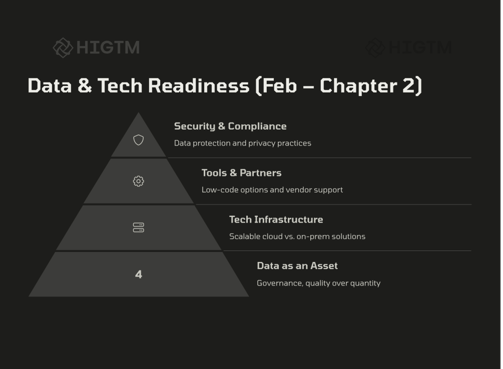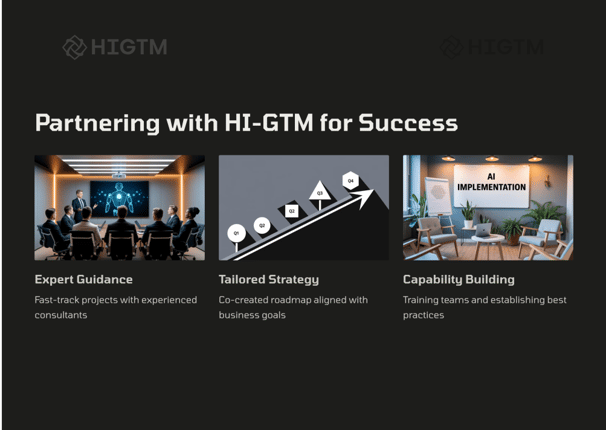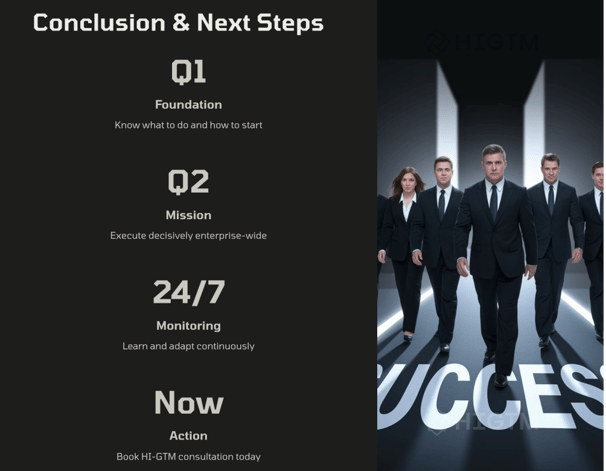90. Q1 Recap & Transition to Q2 Execution
The first quarter of HI-GTM’s AI Adoption Guide (90 daily topics) was all about laying the groundwork. We turned AI from a buzzword into a practical toolkit for SMEs. If Q1 provided the “classroom” theory, Q2 is the “field exercise” – where you put that knowledge into practice. In this recap, we summarize the critical lessons from Q1 – from core concepts and data readiness to initial pilot projects – and why they matter for small and mid-sized businesses. Bottom line: the foundation is set, and the time to execute is now. Early adopters have a brief window to act before competitors seize the advantage. Let’s break down what we learned and how it prepares us for an AI-driven Q2.
Q1: FOUNDATIONS OF AI IN SME MANAGEMENT - CHAPTER 3 (DAYS 60–90): LAYING OPERATIONAL FOUNDATIONS
Gary Stoyanov PhD
3/31/20258 min read

1. Core AI Concepts & Value Proposition (Q1 Chapter 1)
1.1 Defining AI in Business Terms
In Q1, we demystified AI by defining what terms like machine learning and NLP really mean for SMEs. We distinguished AI capabilities from basic automation and framed AI as a practical tool for solving business problems, not sci-fi magic.
1.2 Why SMEs Need AI
We built the business case for AI adoption. Even smaller firms can gain a competitive edge and efficiency by using AI in areas like customer service, marketing, or operations. We identified pain points (e.g. slow manual processes or forecasting errors) where AI can deliver quick improvements.
1.3 Crafting an AI Vision and Strategy
We emphasized creating a clear AI vision aligned to business goals. That meant setting objectives for AI (like improving customer retention or reducing costs) and defining metrics for success. We also highlighted quick wins – small AI projects (e.g. automating a routine task or adding a simple recommendation feature) that can show results in weeks and build momentum.
1.4 Building an AI-Ready Culture
Adopting AI requires the right mindset. Q1 underscored the importance of leadership buy-in and a pro-innovation culture. We encouraged educating teams to dispel myths (like fear of “AI replacing jobs”) and instead show how AI can assist them. Success stories of real SMEs using AI – for example, a retailer boosting sales through personalization – were shared to inspire the organization.
1.5 Addressing Early Challenges
We identified common barriers to AI adoption: limited budget, lack of in-house expertise, data issues, or internal skepticism. Q1 offered tactics to overcome these – start with cost-effective cloud tools to minimize expenses, upskill existing staff or bring in partners for missing skills, and avoid overly ambitious projects initially. We also warned against pitfalls like unrealistic expectations or ignoring data quality.
1.6 Data and Ethics Fundamentals
Even in the early stage, we stressed data and ethics fundamentals. Companies were advised to prioritize data quality over quantity and establish basic data governance. On the ethics side, we highlighted compliance with privacy regulations and the need for transparency in AI use to build trust from the start.
2. Data & Tech Readiness (Q1 Chapter 2)
2.1 Treating Data as a Strategic Asset
In February, the focus shifted to data readiness. We learned to treat data as a strategic asset and craft a basic data strategy. That involved identifying what data we have (and need), improving data quality, and setting up governance (ownership, security, and usage rules). Getting our data house in order ensures any AI projects have solid fuel to run on.
2.2 Building a Robust Data Architecture
We explored data architecture choices. Q1 introduced structured vs. unstructured data and when to use data warehouses vs. data lakes for storage. We stressed data cleaning and integration (understanding ETL – Extract, Transform, Load) so information fed into AI models is reliable. We also encouraged using data visualization and basic analytics to help teams become more data-driven in their decision making.
2.3 Equipping with the Right Technology
Next, we evaluated the AI technology stack. We compared infrastructure options, highlighting that many SMEs can start with cloud-based AI services to minimize upfront costs. Integration was key – often using existing AI APIs or platforms rather than building from scratch. We flagged the importance of cybersecurity (protecting data and access) as systems become more connected. We also weighed vendor vs. in-house solutions – deciding when to use third-party tools or open-source libraries versus developing custom solutions. Many chose a hybrid approach, even trying low-code platforms to experiment quickly without a full data science team.
2.4 Fostering a Data-Driven Culture
We emphasized that technology alone isn’t enough; you need a data-driven culture. Q1 encouraged breaking down data silos between departments and promoting cross-team data sharing. By fostering collaboration (e.g. common dashboards for marketing and operations), we set the stage for AI solutions that benefit multiple areas. When employees routinely use data in decisions, they’ll be more ready to trust and adopt AI insights as a natural extension of their work.
2.5 Developing Talent and Skills
People power AI projects, so we looked at building an AI talent pipeline. SMEs were urged to upskill existing staff (turn a savvy analyst into a junior data scientist) and/or hire for key roles as needed. Q1 laid out core skills to cultivate and encouraged continuous learning so the organization’s AI capability grows over time. Investing in training and creating growth paths for tech-savvy employees helps ensure you have the expertise to execute AI plans.
2.6 Securing Buy-In and Setting Goals
To round out readiness, we stressed aligning stakeholders on AI initiatives. Securing leadership buy-in was essential – we learned to communicate AI benefits in business terms to executives and set realistic expectations. Equally important, we defined clear success criteria for AI projects: specific KPIs and time-bound targets (e.g. “reduce customer response time by 50% in 3 months with a chatbot”). This way, everyone knows what success looks like and can objectively evaluate pilots in Q2.
2.7 Case Study – Data in Action
A manufacturing SME case study illustrated these points. By consolidating sensor data and applying a predictive maintenance AI, a small factory predicted equipment failures and cut unplanned downtime (e.g. by 20%). This real example showed that with good data and a focused use case, even traditional businesses can quickly see ROI from AI – foreshadowing what’s possible when we execute in Q2.
3. Laying Operational Foundations (Q1 Chapter 3)
3.1 From Idea to Implementation
March’s content was about moving from plan to action. We outlined an AI project lifecycle: start with an idea, do a quick proof-of-concept, then a pilot, and if it works, scale up to full deployment. This phased approach manages risk – you validate on a small scale before investing big. By the end of Q1, readers had a template to kick off a pilot in Q2, knowing the checkpoints at each stage.
3.2 Prioritizing High-Impact Projects
Not all projects are equal, so we learned to prioritize. Q1 guided us to choose high-impact, feasible AI projects first. Using simple criteria (impact vs. effort), we picked use cases that could be done in a few months and yield tangible benefits. Focusing on one or two well-chosen pilots (say, automating a customer support task or optimizing inventory with AI) means by the end of Q2 we’ll have meaningful results to show.
3.3 Stakeholder Engagement & Change Management
Even a great AI project can falter without buy-in. We discussed mapping stakeholders (who will use or be affected by the AI) and creating a communication plan to keep them in the loop. Q1 emphasized transparency – explain what the AI will do, address concerns – to prevent confusion or fear. We also prepared for change management: training employees on new tools, phasing in changes, and making sure people understand AI is there to assist, not replace them. Handling the human side of AI adoption was key to ensuring our Q2 implementations will be embraced, not resisted.
3.4 Strengthening the AI Team
We revisited our team and talent in an operational context. Once AI pilots start, the people running them (internal experts or partners) are critical. Q1 taught us to retain and empower AI talent – give them growth opportunities and recognition – so we don’t lose them after investing in their skills. We also encouraged a learning culture: as new tools roll out, the team should continuously upskill (e.g. learning to fine-tune models or interpret AI results). The better we support our team, the stronger our execution in Q2 will be.
3.5 Monitoring and Iteration
Deploying an AI pilot isn’t “set and forget.” We set the expectation of constant monitoring and improvement. That means establishing KPIs and dashboards to track how the AI is performing (accuracy, usage, impact on key metrics) and reviewing them regularly. We’re ready to adjust based on feedback – retrain a model, tweak a process, or even pause a project if it’s not delivering. Q1 fostered a continuous improvement mindset: every outcome (good or bad) is feedback to make our solutions better. This ensures that in Q2 our AI implementations actually get smarter and more effective over time.
3.6 Governance and Risk Management
As AI integrates into operations, governance becomes vital. We put basic AI governance frameworks in place: guidelines for ethical use, data privacy, and oversight for AI initiatives. We also identified risks (financial, operational, ethical) and mitigation plans. For example, we decided to keep humans in the loop initially for critical decisions to ensure oversight, and to regularly test AI outputs for bias or errors. By handling governance and risk early, we set ourselves up to scale AI responsibly in Q2 without unexpected surprises.
3.7 Planning for Scale
We didn’t want to stop at a successful pilot; we planned for scale. Q1 had us outline how to go from pilot to broad adoption. This meant creating a roadmap: if the pilot works, when and how do we roll it out company-wide? We also talked about avoiding over-engineering early on – keep the solution simple until it proves value, then invest in robust scaling. Additionally, we considered partnering with vendors or consultants for deployment expertise. Having this scale-up plan means the moment a Q2 pilot succeeds, we can amplify its benefits across the enterprise.
3.8 Celebrating Wins & Future Outlook
Finally, Q1 wrapped up by encouraging us to recognize progress and stay forward-looking. We were reminded to celebrate small wins (like a pilot hitting its target) to build morale and support. And we got a preview of emerging trends (e.g. generative AI) that could shape the future. This was a nudge to keep learning and stay agile – the AI landscape evolves quickly, and a company that mastered Q1’s basics will be well-positioned to exploit new innovations in Q3 and Q4. But first, the focus is on executing these fundamentals in Q2.




4. From Foundation to Execution – The Q2 Imperative
4.1 The Cost of Inaction
Q1 gave us the knowledge – but knowledge alone doesn’t create value; execution does. Many peers are already on the move: over half of SMBs now use some form of AI in their operations. Those who have embraced AI report clear benefits (91% of AI-driven SMBs say it has boosted their revenue). Early adopters are pulling ahead, and late adopters risk falling behind as the gap widens. Every quarter of delay is a quarter your competition is improving or cutting costs with AI.
4.2 From Plans to Results
Q1’s lessons arm you with a plan – now Q2 is about putting it to work. Focus on the high-impact projects you’ve identified, launch them, and closely track the outcomes. Maintain the agile mindset: monitor progress, iterate quickly, and scale up what works. This is the time to turn pilots into real productivity gains or customer wins. By acting decisively now, you can capture the rewards of AI while others are still getting up to speed.
4.3 Leverage Expert Support
If you’re unsure how to begin or want to accelerate your efforts, consider partnering with experts. HI-GTM specializes in guiding businesses through this execution phase. We help organizations avoid pitfalls, implement best practices, and tailor AI rollouts to their goals. A seasoned partner can fast-track your journey – ensuring that the hard work of Q1 translates into tangible success in Q2.
4.4 Embrace AI Execution
The foundation is laid and the blueprint is in hand. Now is the moment to build on it and transform your business with AI. The window to gain an AI advantage is open – but it won’t stay open forever. Companies that move from planning to doing, starting now, will lead their markets. With urgency, focus, and the right support, you can make this next quarter the turning point where AI shifts from concept to competitive edge on your bottom line.


Turn AI into ROI — Win Faster with HIGTM.
Consult with us to discuss how to manage and grow your business operations with AI.
© 2025 HIGTM. All rights reserved.
